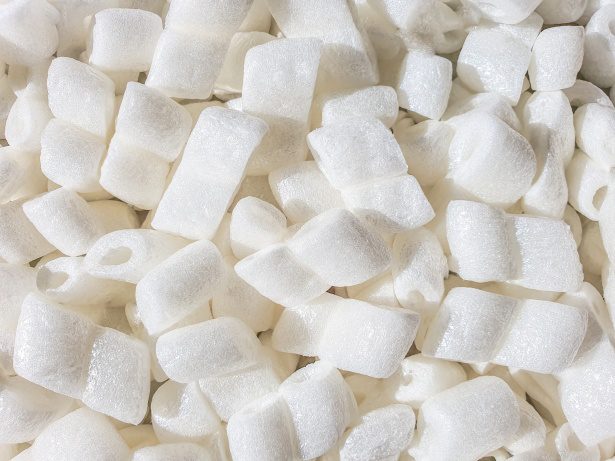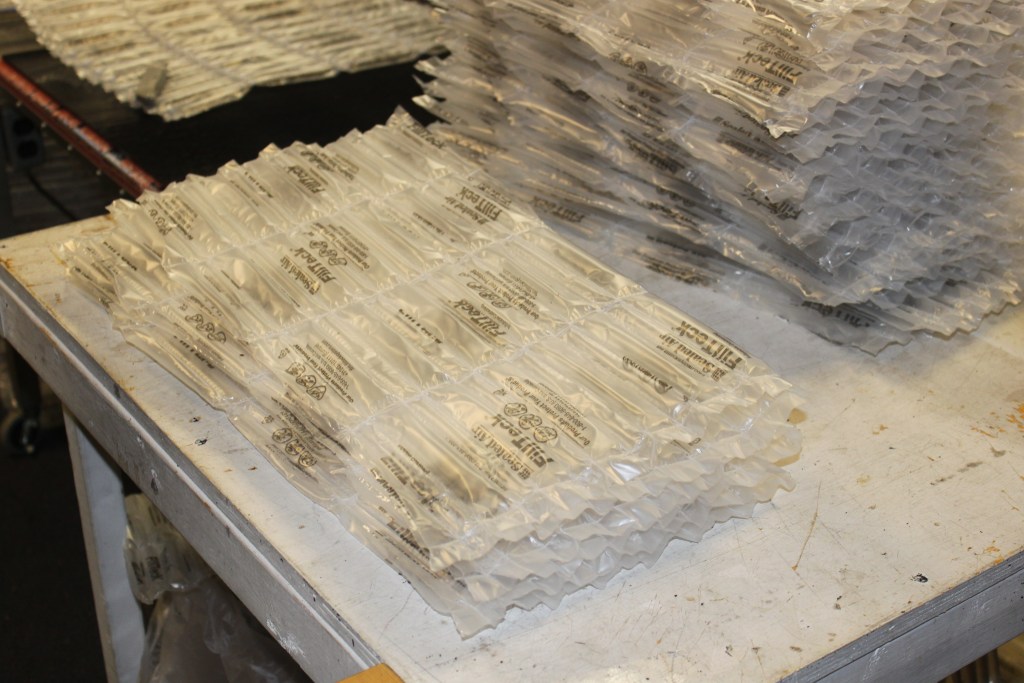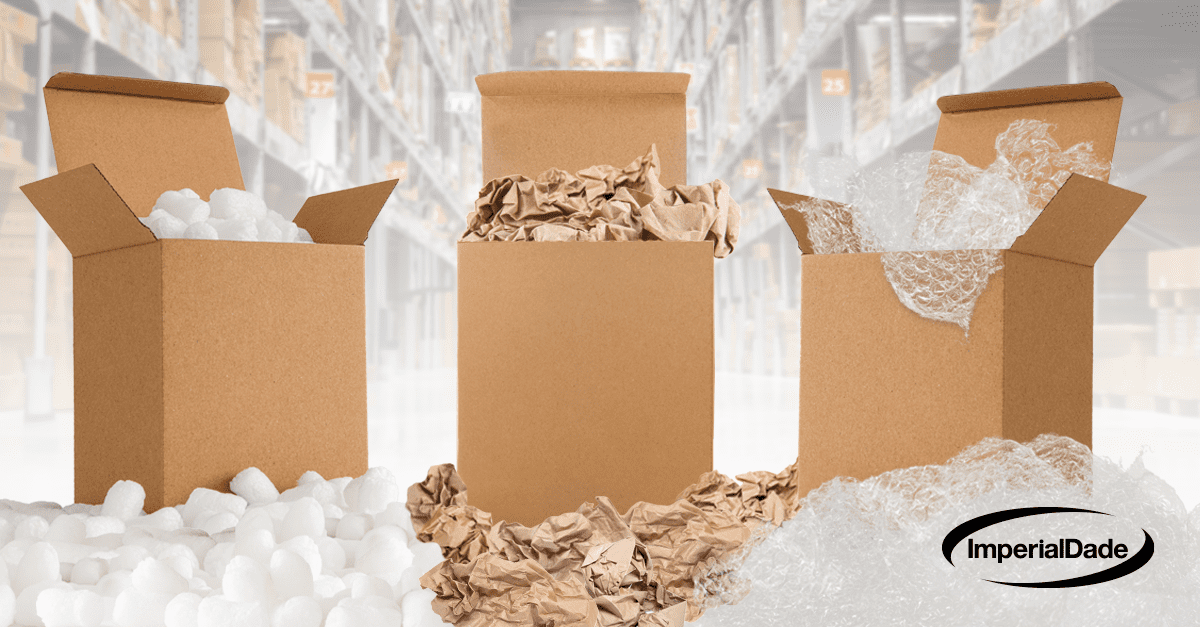Whether transporting goods on a truck, boat, or airplane, there will always be some amount of bumping, shifting, or moving that the package will have to endure. On top of that, packages are often subject to accidental drops, flips, and crushes.
When not packed properly, the goods you’re shipping can become damaged or even break, leading to lost products, increased costs, and an upset customer.
Void fill also helps to enhance the experience for the customer and ensure a seamless delivery by securing products within the package. As a result, void full helps to prevent damage and protect your business from lost revenue.
But what exactly is void fill? How much should be used? Which type is best for the goods you’re shipping?
Today, we have an article and video for you that will answer each of these questions and more!
What is Void Fill Packaging?
Void fill packaging is any material, usually made from paper, foam, or plastic, placed inside a box or package that is designed to minimize the risk of contents becoming broken or damaged during transit.
It can do this by occupying the space between a box or package and its contents, effectively securing the product in place.
Pro Tip: It is a common misconception that void fill is designed to protect items; however, it’s actually designed to prevent items from moving around inside the package.
If you’re looking to protect fragile items, you should consider protective packaging instead of or in addition to void fill. A simple way to tell the difference is that protective packaging is wrapped around goods, cushioning them, while void fill is stuffed into the gaps between the goods and the box.
When Do You Need Void Fill for Your Packaging?
Ask yourself, “Can I comfortably flip this package over or jostle it around without worrying that the goods may get damaged?” If you’re not comfortable flipping or jostling the package then chances are you should use void fill.
Another easy way to tell whether you need to use void fill is by filling a box with goods and sealing it. Is the box full? If there’s leftover room, you will likely want to use void fill.
The question now becomes, how much void full is enough?
How Much Void Fill To Use
Generally speaking, the exact amount isn’t a science. Your best bet is to fill the package so that the goods are completely surrounded, immobilizing the item(s).
A good test for whether you need more void fill is to assess whether you’d be comfortable dropping the package on the ground from several feet up. If you’re comfortable with this, and the goods seem secure enough to you after dropping the package, then you’re good to go.
If you’re uncomfortable at the thought of the package falling several feet because you think the content could be damaged, then you know you need more.
Your best bet is to use as much void fill as it takes for you to be comfortable with the packaging sustaining a fall.
Types of Void Fill Packaging
In this section, we’ll cover five of the most common void fill options.
These options are:
- Packaging Paper
- Crinkle Paper
- Packing Peanuts
- Air Pillows
- Bubble Wrap
Let’s start by taking a look at packaging paper.
1. Packaging Paper
What is Packaging Paper?
Packaging paper can be made from any type of paper, though kraft paper is the most commonly used for void fill. That’s because kraft packaging paper is an affordable and eco-friendly alternative to plastic void fill.

Pro Tip: Kraft paper packaging comes in many forms, including recyclable, biodegradable, and compostable options.
When to Use Packaging Paper
If you’re looking for a sustainable void fill option or want to keep costs low, kraft paper packaging is the option for you.
How Much Does Packaging Paper Cost?
Packaging paper costs will differ depending on the type of paper used, but it is still one of the most affordable options out there. As such, it will almost always be more affordable than any plastic form of void fill.
2. Crinkle Paper

What is Crinkle Paper?
Crinkle paper is similar to the paper packaging we just covered, but it comes in a shredded form.
When to Use Crinkle Paper
The accordion-like design allows this form of void fill to flatten so that it can easily fit into gaps. Because it can easily fit gaps, crinkle paper is a good general-use void fill. However, crinkle paper is usually heavier and less durable than other forms of void fill, so it may not be the most effective option for you.
How Much Does Crinkle Paper Cost?
Much like packaging paper, crinkle paper is one of the more affordable varieties of void fill and comes in a variety of eco-friendly options.
This is a good option if you don’t have the budget for an alternative void fill.
3. Packing Peanuts
What are Packing Peanuts?

Packing peanuts are one of the most recognizable forms of void fill. They’re very lightweight and come in small, peanut-shaped pieces that are traditionally made out of polystyrene, also called Styrofoam.
When to Use Packing Peanuts
Packing peanuts are particularly effective at filling voids that are inaccessible to other void-fill materials because of their small size and unique interlocking design.
How Much Do Packing Peanuts Cost?
This form of void fill can be more affordable than plastic alternatives but will almost always be more expensive than paper alternatives.
4. Air Pillows
What are Air Pillows?
Air pillows often come in flat, plastic sheets that are inflated with air to create a large, film cushion.

While air pillows can come in the form of paper, they can also be made from recycled poly, biodegradable poly, and many other eco-friendly forms. A unique attribute of air pillows is that they can be customized to include branding or advertisements.
When to Use Air Pillows
The large size makes this form of void fill ideal for filling large packages that have large voids between the box and the goods inside.
How Much Do Air Pillows Cost?
This form of void fill isn’t as popular because a specific machine is required to inflate the air pillows, creating a large upfront cost. However, if you have the required machine, air pillows become the more cost-effective of the two plastic void fills in this article.
5. Bubble Wrap
What is Bubble Wrap?
Bubble wrap is another popular form of plastic void fill. This option can also be used to wrap products, making it protective packaging. It’s particularly ideal for use with fragile or oddly shaped items.

This type of void fill resembles a smaller version of air pillows. It also comes in plastic sheets but doesn’t have to be filled up using a machine as it’s already filled with air.
When to Use Bubble Wrap
Bubble wrap is the best option if you’re shipping fragile goods or are otherwise worried about package contents becoming damaged, as it provides excellent cushioning.
How Much Does Bubble Wrap Cost?
Bubble wrap is usually more expensive than the other options on this list, however, many businesses already use bubble wrap as protective packaging. Due to already having bubble wrap in stock, it can be cheaper to use instead of purchasing a separate form of void fill.
As a result, this could be one of the more cost-effective options in this article.
What is the Best Void Fill Packaging?
There is no one best void fill option; it just comes down to what you’re shipping and how it’ll be shipped.
If you’re shipping an oddly shaped item, consider using packing peanuts. If there is a lot of excess space between the good and the package, use a form of void fill that is good at fitting tightly into small gaps, like packing paper or crinkle paper. If your goods fit pretty well within the package, consider throwing a little bubble wrap or a few air pillows in there just to make sure everything stays snug.
Final Thoughts
When transporting goods, there is always the risk that something will be damaged. You can minimize that risk by using the right void fill.
Hopefully, this article has helped you land on a void fill option that will best fit your needs. If you have any further questions or are interested in learning more about which void fill is best for your business, reach out to your nearest Imperial Dade facility.
You can set up a free consultation with one of our highly trained packaging specialists, and they’ll help walk you through every available option until we find the void fill best suited for you.
Check Out These Related Articles:
- Stretch Wrap 101: What Is Industrial Plastic Wrap, Types of Plastic Stretch Wrap, & How to Use
- Stretch Wrap 101: How to Save Money with the Right Stretch Wrap Dispenser
- Industrial Packaging Tape: Everything You Need to Know
- Edge Protectors 101: Everything You Need to Know
- 3 Innovative Material Handling Solutions from Rubbermaid Commercial Products
